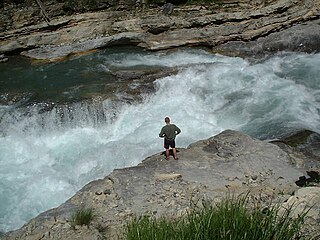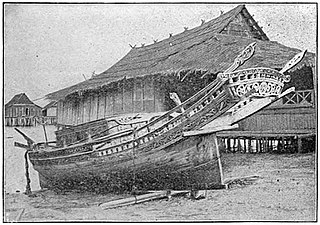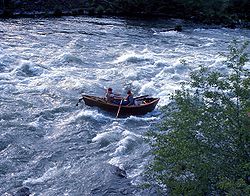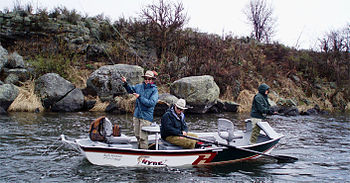
A hull is the watertight body of a ship, boat, or flying boat. The hull may open at the top, or it may be fully or partially covered with a deck. Atop the deck may be a deckhouse and other superstructures, such as a funnel, derrick, or mast. The line where the hull meets the water surface is called the waterline.

A kayak is a small, narrow human-powered watercraft typically propelled by means of a long, double-bladed paddle. The word kayak originates from the Greenlandic word qajaq.

A dory is a small, shallow-draft boat, about 5 to 7 metres or 16 to 23 feet long. It is usually a lightweight boat with high sides, a flat bottom and sharp bows. It is easy to build because of its simple lines. For centuries, the dory has been used as a traditional fishing boat, both in coastal waters and in the open sea.

A dinghy is a type of small boat, often carried or towed by a larger vessel for use as a tender. Utility dinghies are usually rowboats or have an outboard motor. Some are rigged for sailing but they differ from sailing dinghies, which are designed first and foremost for sailing. A dinghy's main use is for transfers from larger boats, especially when the larger boat cannot dock at a suitably-sized port or marina.

Whitewater forms in a rapid context, in particular, when a river's gradient changes enough to generate so much turbulence that air is trapped within the water. This forms an unstable current that froths, making the water appear opaque and white.

Boat building is the design and construction of boats and their systems. This includes at a minimum a hull, with propulsion, mechanical, navigation, safety and other systems as a craft requires.
The Banks dory, or Grand Banks dory, is a type of dory. They were used as traditional fishing boats from the 1850s on the Grand Banks of Newfoundland. The Banks dory is a small, open, narrow, flat-bottomed and slab-sided boat with a particularly narrow transom. They were inexpensive to build and could be stacked or nested inside each other and stored on the decks of larger fishing vessels which functioned as mother ships.

The Gloucester dory is a variant of the Banks dory, a type of narrow-bottomed, slab-sided boat, common in the North Eastern United States. It is characteristically smaller and lighter, with less overhang, both bow and stern, and less freeboard. It retains the Banks dory's slab sides. Gloucester dories were designed to be launched through the surf behind a breakwater for daily fishing and lobstering off the Massachusetts shore.
The Jersey Skiff is a beach launched boat first appearing around the end of the 19th century. They were first used as fishing boats, to be launched through the surf, sailed to the fishing grounds and then retrieved through the surf.

Rowing is the act of propelling a human-powered watercraft using the sweeping motions of oars to displace water and generate reactional propulsion. Rowing is functionally similar to paddling, but rowing requires oars to be mechanically attached to the boat, and the rower drives the oar like a lever, exerting force in the same direction as the boat's travel; while paddles are completely hand-held and have no attachment to the boat, and are driven like a cantilever, exerting force opposite to the intended direction of the boat.

The Durham boat was a large wooden, flat-bottomed, double-ended freight boat which was in use on many of the interior waterways of North America beginning in the middle of the eighteenth century. They were replaced by larger, more efficient canal boats during the canal era beginning with the opening of the Erie Canal in 1825. The Durham name became associated with this boat type due to their use by the Durham Ironworks of Durham, Pennsylvania for hauling freight on the Delaware River. They are also noted for their use in George Washington's crossing of the Delaware River during the American Revolution.

A fishing vessel is a boat or ship used to catch fish and other valuable nektonic aquatic animals in the sea, lake or river. Humans have used different kinds of surface vessels in commercial, artisanal and recreational fishing.

A Dutch barge is a traditional flat-bottomed shoal-draught barge, originally used to carry cargo in the shallow Zuiderzee and the waterways of Netherlands. There are many types of Dutch barge, with characteristics determined by regional conditions and traditions.

Traditionally, many different kinds of boats have been used as fishing boats to catch fish in the sea, or on a lake or river. Even today, many traditional fishing boats are still in use. According to the United Nations Food and Agriculture Organization (FAO), at the end of 2004, the world fishing fleet consisted of about 4 million vessels, of which 2.7 million were undecked (open) boats. While nearly all decked vessels were mechanised, only one-third of the undecked fishing boats were powered, usually with outboard engines. The remaining 1.8 million boats were traditional craft of various types, operated by sail and oars.

The Tancook Schooner is a sailing work boat design credited with influencing North American yacht designers and pleasure craft users during the early to mid twentieth century.

The McKenzie River dory, or drift boat, is an adaptation of the open-water dory converted for use in rivers. A variant of the boat's hull is called a modified McKenzie dory or Rogue River dory. The McKenzie designs are characterized by a wide, flat bottom, flared sides, a narrow, flat bow, and a pointed stern. The sole identifying characteristic of the McKenzie River dory is a continuous rocker. It is this constant rocker that allows the boat to spin about its center for ease in maneuvering in rapids.
Cajune Boats is a custom manufacturer of wooden drift boats in Montana. It was established as Montana Boatbuilders in 1996 in Whitefish, Montana. The business is owned by Jason Cajune and the paddle fishing boats, including the Kingfisher, are produced near the Yellowstone River. Fiberglass, epoxy and modern technology are incorporated into the boat designs.

Lepa, also known as lipa or lepa-lepa, are indigenous ships of the Sama-Bajau people in the Philippines and Malaysia. They were traditionally used as houseboats by the seagoing Sama Dilaut. Since most Sama have abandoned exclusive sea-living, modern lepa are instead used as fishing boats and cargo vessels.
The Greenwich 24 is an American trailerable sailboat that was designed by George H. Stadel Jr. as a cruiser-racer and daysailer. It was first built in 1968.
The Cape Dory 25, also called the Cape Dory 25 Mark I, is an American trailerable sailboat that was designed by George H. Stadel Jr. as a cruiser and first built in 1973.



















